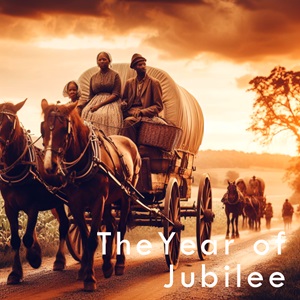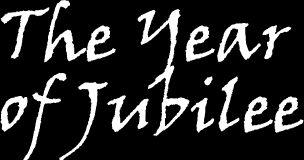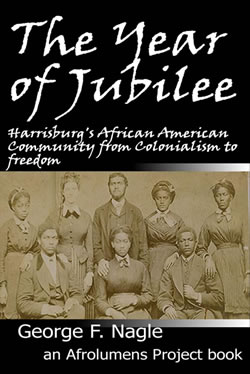

a book about Harrisburg
Study Areas:
The Year of Jubilee -- Table of Contents (clickable links)
Volume One: Men of God
Part I: Introduction
Chapter 1—The Torrent 13
Chapter 2—The Bridge—25 June 1863 21
Chapter 3—Origins 45
May 1749, Harris’ Ferry 46
Hercules 50
Seeds of Community 64
Part II: Rising Waters
Chapter 4—Legacy of Slavery 71
Agricultural Slaves 72
Industrial Slaves 86
Tradesmen and Others 94
Buying a Slave 113
May Pass by that Name 145
Life—“Our Colored People” 154
Death 170
Chapter 5—Dogs, War, and Ghosts 181
Unlike the Men, More Ferocious Than Wild Beasts 181
Secret and Dangerous Paths 196
Dogs 199
War 209
Supposed to be Gone to the Enemy 219
Ghosts 242
Chapter 6—No Haven on Free Soil 251
For You Know the Negroes are Slaves 257
Every Slave a Domestic Enemy 264
He Has Some Friends Living in a Cedar Swamp 271
If Not Secreted by Negroes in Philadelphia 278
It Becometh Not Us to Counteract His Mercies 293
On Claim of the Party 311
I Notify Any Person That Can Have Claim to Me 316
The Talons of the Kidnappers 319
Cash in Market 327
Behold the Natural Result of Fanatical Legislation 347
Part III: Approaching Storms
Chapter 7—Rebellion 357
1820s 370
The Pioneering Entrepreneurs 373
1830s and the Second Generation Entrepreneurs 384
A Course Unwise, Fanatical, and Disorganizing 405
For the Down Trodden and Oppressed 413
From That Time the Cause Has Been Onward 444
1840s: The Defiant Decade 447
Welcoming the Anti-slavery Pilgrims 453
Underground Railroad in Harrisburg and Central Pennsylvania 468
The Underground Road: To and From 480
Men of God 483
The Good Doctors Rutherford and Jones 525
Tanners Alley 534
Notes 541
About the Author 607
Volume Two: Men of Muscle
Part III: Approaching Storms
Chapter 8—Backlash, Violence, and Fear: The Violent Decade 5
Violent Beginnings 11
Plentifully Besprinkled with Blood 26
The Law is an Abomination 31
Harrisburg’s Slave Commissioner 40
1851: September 11 60
It Was Time a Fuss Was Made 64
Standing Up Like Men 73
This Insurrectionary Movement 81
Kidnapping and Murder 87
Bullet Emancipation 104
This Nation Will Yet Weep 113
Ousting the Bloodhounds 123
The End of Solomon Snyder 129
The Book-Keeper Arrives 135
Exciting Times 142
The Struggle Intensifies 155
Intense Excitement Ensued 175
Doctor Jones Comes to Independence Hall 184
Legacy 191
Chapter 9—Deluge 199
You Should be Told What This All Means 211
The Harrisburg-Harpers Ferry Connections 219
A Kidnapper Kidnapped 230
The 1860s 238
The City is Weekly Invaded with New-comers 239
We Can do for Ourselves 251
Flags, Streamers, and Banners 255
In the Hands of the People 257
Like a Thief in the Night 260
Harrisburg as a War Town 270
More Than Ordinary Vigilance 274
The Negroes…Have Become Troublesome 284
Realities of War 288
Part IV: Year of Jubilee
Chapter 10—The Bridge 315
Roll Forward the Day 321
Speaking Trumpet-tongued 331
The Master Spirit of the Negro War Element 344
Spring 1863: Instruments in the Hands of God 356
May 1863: Blood is Cheap 361
8 June 1863: The Gospel Trumpet Hear 384
11 June 1863: Wars and Rumors of Wars 391
12 June 1863: Blow Ye the Trumpet, Blow 395
13-14 June: How Many Colored Troops? 399
The Telegrapher 403
The Pianist 404
The Schoolteacher 405
The Editor 406
The Commanders 407
The Engineer 408
The Politician 410
The Refugees 413
The Patriots 414
16 June 1863: The “Hegira” 415
Men of Muscle 418
Devil Take the Poets 423
17-18 June: It is Well to Avoid all Controversy 434
Calm Once More 442
Thursday, 25 June: The Bridge 448
The First Hot Breath of War 456
War Meeting 462
Friday, 26 June: The Colored Troops of Harrisburg 472
27 June: The Whole South are Coming 474
Sunday, 28 June 1863: “We…are even now ready to give them a wrestle” 478
Mohammed Khan 484
Sunday Night: Like So Many Burning Ships 485
29 June 1863 495
The Year of Jubilee is Come 507
Notes 523
Bibliography (Word Doc, download) 597
About the Author 627
Purchase print copies on Amazon. Click the cover images.

Supplemental Human Interest Stories
Year of Jubilee promotional poster
This is the first in a series of books from the Afrolumens Project. Drawing on a large number of sources, and making good use of the treasure trove of information on the pages of the Afrolumens Project, this is the first truly comprehensive history of Harrisburg's African American community.
Synopsis for The Year of Jubilee
In late June of 1863, Harrisburg’s African American community witnessed the influx of refugees streaming into town from the Cumberland Valley, fleeing the rapidly advancing invasion forces of General Robert E. Lee. Among the panicked and footsore mobs were hundreds of people of color like themselves who had abandoned their homes and businesses, most escaping with little more than the clothing on their backs, all in the hope of preserving the one possession that was most dear to them: freedom. This book tells the story of the struggle faced by African American people in and around Harrisburg to establish their freedom, and to maintain it over the decades against the corroding effects of racism, economic hardship, and civil war. It traces the beginnings of that community as it emerged from a legacy of slavery in the mid-1700s and follows it through the development of social institutions, ultimately achieving social and economic independence. The constant struggle by this community to defend that independence, and its resulting freedom, against everyone from paternalistic local lawmakers to predatory kidnappers, is a theme that runs throughout the book, culminating in the momentous decision in June 1863 to make a stand in Harrisburg against the Confederate invasion.
The book uses a storm metaphor to convey the story of the development of the African American community of Harrisburg from the Colonial period through June 1863. The first chapter summarizes the violent events that preceded the Civil War, from John Brown’s raid to the point of the Confederate invasion in June 1863, and the efforts of Harrisburg’s African American residents to survive the rising waters of history through their faith and sense of community. The narrative follows a group of weary African American refugees as they fled the Cumberland Valley in the wake of the invading Confederate forces, toward the bridge at Harrisburg that they hoped would lead them to a safe haven; a bridge that in the past had symbolized the line between bondage and freedom, and now was the safe passage over turbulent waters.
It then pulls back from the eve of the 1863 crisis to the earliest time that African Americans came to Harrisburg in search of safe haven, and it explores the African-born men and women who first passed through and lived here. The storm imagery is continued through the next three chapters, which detail the events and social forces that contributed to the showdown between the North and the South. Subjects include a detailed look at all aspects of the institution of slavery as it existed in Pennsylvania, and particularly in the greater Harrisburg area, an examination of the mortal dangers faced by slaves who attempted to escape their condition by flight, focusing on the grim determination that drove tens of thousands of people to risk horrifying journeys to satisfy the basic human desire for self determination, and background information on the political landscape, the legislation and the diplomatic maneuvering between North and South, settlers and Native Americans, farmers and legislators, to attempt to settle the slavery issue, and even more importantly, the fugitive slave issue.
With background information in place, the book moves on to an in-depth history of the development of Harrisburg’s free African American community during the three decades prior to the Civil War, as it experienced the exhilaration of standing up against slavery, the frightening consequences of that rebellion, and the sobering realization that only a bitter civil war would finally settle the slavery issue. Extensive attention is paid to the development of Harrisburg’s free African American community concurrent with the rise of anti-slavery sentiment in central Pennsylvania, and its bold challenge to the slave powers, which took the form of social lobbying, legislation, organizing, and, with the Underground Railroad, outright defiance of the law. A chapter is devoted to detailing the violent events of the 1850s, as the slave powers fought back against the abolitionists, and incidents in central Pennsylvania and elsewhere rapidly escalated into highly emotional retaliatory gestures. This section reaches the book’s penultimate climax with the telling of how John Brown’s raid and secession opened the floodgates that brought the deluge of two years of war to Harrisburg, bringing the reader to Harrisburg at the beginning of the year 1863.
The
book concludes with the events of the year 1863 as experienced by Harrisburg’s
African American residents, and concludes with their determination
to help defend Harrisburg against an expected attack by superior Confederate
forces, despite more than one hundred and fifty years of social and
political repression from the dominant culture. It brings the reader
back to the bridge into Harrisburg, where the weary fugitives are waiting
to cross, and follows the daily events to the climax of the story,
which occurs on June 29, 1863, as two companies of black volunteer
soldiers cross the bridge to help defend the city from the invading
enemy forces. An epilogue gives a summation of the events that followed
for the remainder of the war, and the effect that the decision by the
local African American community to stand and fight had on their relationship
with the dominant European American community.


